Matador Network's Blog, page 74
January 22, 2025
2025’s Best Cruises: Sail From the Azores to Amsterdam on a Tall Ship in August
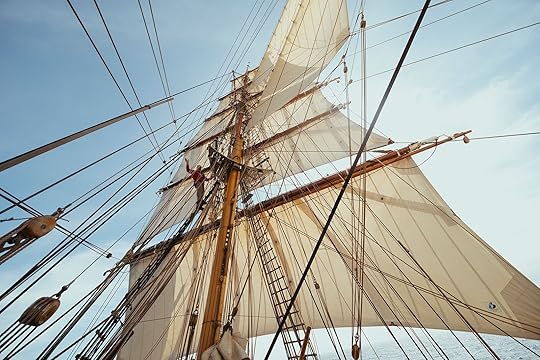
See the full list of the best cruises to take in 2025
Sailing on Bark Europa is nothing like the experience on a regular cruise ship. Bark Europa is a modernized 1911 tall ship, so there aren’t any amenities like a spa, pool, casino, or specialty restaurants, but that doesn’t mean there’s nothing to do while on board this very special vessel. As soon as passengers embark, they become part of the crew and participate in the handling of the ship for the duration of the voyage.
Key facts
Highlight: Sail to Amsterdam to celebrate the city’s 750th anniversary and attend the Sail Amsterdam 2025 eventWhen: 20 days, starting August 2Ship Capacity: Bark Europa can accommodate up to 48 passengersStarting Price: From $3,385 per person
Learn More
That’s what travelers who sign up for the Azores-to-Amsterdam voyage in August will do during the 20-day sailing. They will stand at the helm, handle the sails, and learn how to sail a square rigger across parts of the Atlantic Ocean, through the infamous Bay of Biscay, and across the English Channel — the busiest waterway in the world. Thanks to everyone’s effort, the ship will arrive in the port of Amsterdam just in time for the Sail Amsterdam 2025 event.
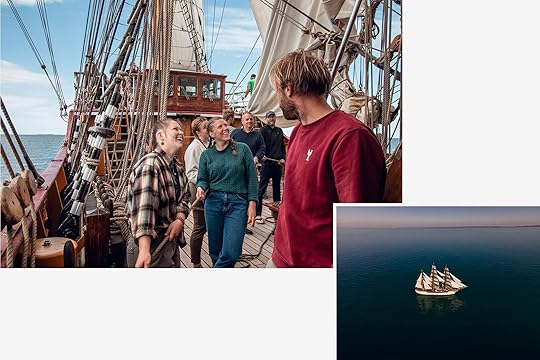
Photos: Jack Cox/Bark Europa
Sail Amsterdam is a five-day maritime festival that attracts millions of visitors and over 10,000 ships, including dozens of historical tall ships from around the world, to the port of Amsterdam. This year, the event will be extra special as it will coincide with the 750th anniversary of the city of Amsterdam.
The sailing from the Azores to Amsterdam is the final leg of a much longer journey that Bark Europa will take in 2025. The 81-day trip, which is bookable on Bark Europa’s website, will start on May 31 in Namibia, from where the ship will follow the trade winds to Brazil before heading to the Azores and, finally, Amsterdam. 
2025’s Best Cruises: Norway’s Coastline With Hurtigruten in February
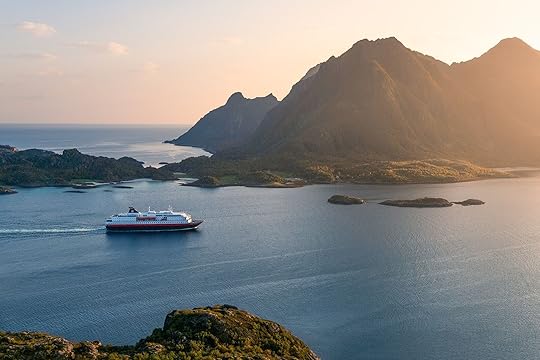
See the full list of the best cruises to take in 2025
Norway’s long February nights provide an excellent chance to view the northern lights. And on Hurtigruten’s Coastal Express route, you’ll have exceptional conditions (and guidance) to do so. Hurtigruten is so confident that you’ll have an opportunity to experience the aurora borealis that it offers a complimentary six- or seven-day cruise if the northern lights fail to appear during your cruise.
Key facts
Highlights: 34 stops along the coast of Norway with a guaranteed aurora sightingWhen: 11 days, multiple start dates throughout the month and yearShip Capacity: About 490, depending on the shipStarting Price: From $3,522 per person
Learn More
The 11-day trip stops at 34 ports. Departing from Bergen, the ship sails through the dramatic Hjørundfjord before progressing northward, passing the Lofoten Islands and then entering the Arctic Circle. Kirkenes, situated near the Russian border, is the final destination before going back down the west coast of Norway to Trøndelag. The voyage offers one of the most comprehensive cruise explorations of Norway’s coastline and its diverse landscapes, from the fjords to the Arctic wilderness.
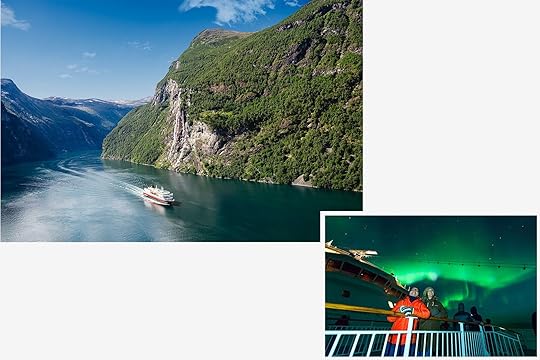
Photos: Agurtxane Concellon and Orjan Bertelsen
Excursions are plentiful, too. There are over 70 on offer, including guided hikes through breathtaking landscapes, visits to historical sites (such as Viking settlements and traditional fishing villages), dog sledding across the frozen tundra in Kirkenes, and kayaking in the Lofoten Islands. 
2025’s Best Cruises: Explore the Caribbean on MSC’s New Ship in April
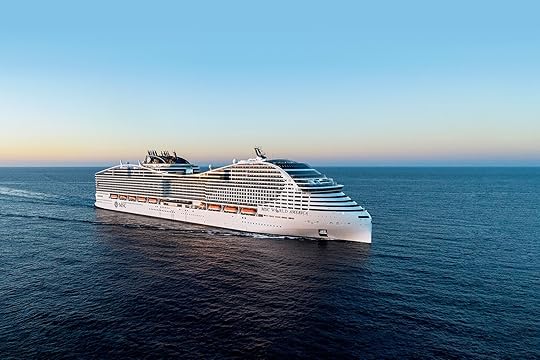
See the full list of the best cruises to take in 2025
MSC’s long-awaited MSC World America will make its grand debut on April 12, 2025. The seven-day maiden voyage starts in Miami, the largest cruise port in the world, with stops in the Dominican Republic, Puerto Rico, and the Ocean Cay MSC Marine Reserve in the Bahamas before returning to Miami. Travelers who wish to make this trip aboard a new ship last a little longer can opt for the 14-day option, which combines the sailing experience above to the western Caribbean with stops in Mexico and Honduras.
Key facts
Highlight: Maiden voyage around the Caribbean of the MSC’s new ship, the MSC World AmericaWhen: Seven or 14 nights, starting April 12Ship Capacity: MSC World America accommodates up to 6,764 passengersStarting Price: From $994 per person for the seven-day sailing, and from $2,355 per person for the 14-day sailing
Learn More
MSC World America, currently still under construction in France, is the sister ship to MSC World Europa, the largest ship sailing the Mediterranean. While similar, MSC World America will feature the first overwater swing ride in the world, a ropes course, a shark-shaped slide named the Jawdrop, a sports bar, and the first Eataly at sea — all of which travelers will be able to try out during this maiden voyage. 
2025’s Best Cruises: Celebrate 4th of July in Alaska With Holland America
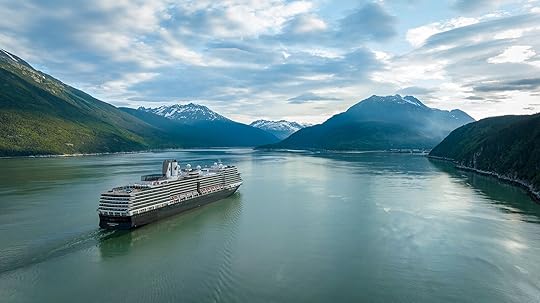
See the full list of the best cruises to take in 2025
Holland America offers patriotic Americans the chance to celebrate the Fourth of July in the most epic of ways: by exploring the wilderness of Alaska.
Key facts
Highlight: Spend Independence Day in Juneau, the capital of AlaskaWhen: Seven days, starting July 2Ship Capacity: Zaandam can accommodate up to 1,432 passengersStarting Price: From $1,139 per person
Learn More
This incredibly scenic seven-day sailing that begins and ends in Vancouver, Canada, will take you through the Inside Passage, along the Alaskan coast, and all the way north to Glacier Bay National Park. On July 4, the Zaandam will make a lengthy stop in Juneau, the capital of the state of Alaska, where you’ll have a choice of exciting excursions, including a helicopter ride followed by a hike on top of Mendenhall Glacier, a kayak adventure, a paddle on board a traditional Indigenous canoe, a whale-watching trip, and many more.
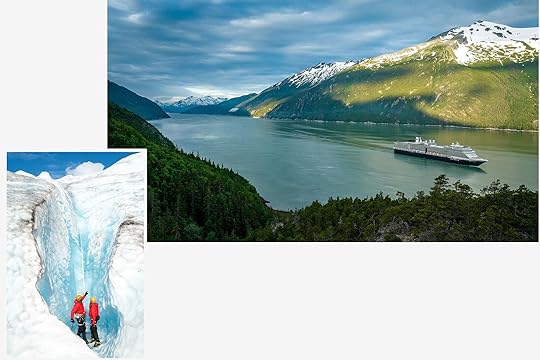
Photos: Holland America Line
Holland America has been sailing to Alaska for over 75 years and they know how to make a trip to The Last Frontier very special. On the fifth day of the cruise, the ship will sail to Glacier Bay National Park and National Park rangers will jump onboard to provide passengers with all the information they need to know about this very special place. Expect to be blown away by the scenery and the wildlife you’ll see (otters, seals, dolphins, and more) as you sail through the narrow bay. 
2025’s Best Cruises: Cross the Atlantic on a Windjammer With Sea Cloud Cruises in November
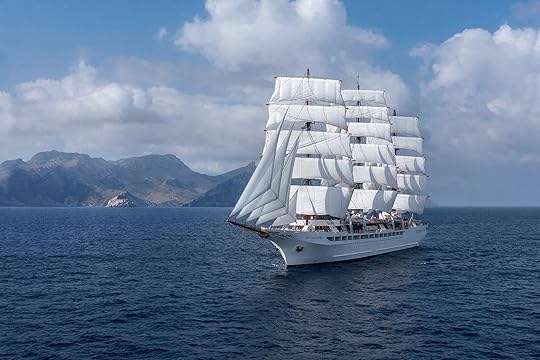
See the full list of the best cruises to take in 2025
Once a year, in November, two of the three windjammers operated by Sea Cloud Cruises take passengers across the Atlantic. Sea Cloud II and Sea Cloud Spirit, two modern three-masted tall ships, leave from either the Canary Islands or Cape Verde and follow the trade winds all the way across the ocean to either St. Marteen or Barbados. Because this sailing happens only once per year, and because each ship can only accommodate a very limited number of passengers, this is a very special voyage to take part in.
Key facts
Highlight: Cross the Atlantic in a modern windjammer by following the trade winds from the Canary Islands to St. MarteenWhen: 16 nights, starting November 11Ship Capacity: Sea Cloud Spirit can accommodate up to 136 passengersStarting Price: From $10,455 per person
Learn More
Despite its traditional rigging and historical appearance, Sea Cloud Spirit is the newest ship of the fleet: built in 2020 and launched in 2021. That means that there are modern amenities on board that make for a very comfortable transatlantic sailing, including a sauna, a steam bath, a relaxation room, a good-size restaurant, and even an elevator. Also, sailing on board Sea Cloud Spirit, as opposed to Sea Cloud II, means you’re saving around $9,000 on the price of the voyage.
A transatlantic voyage with Sea Cloud Cruises involves being at sea without any stops for 16 or 17 nights. It’s the perfect occasion to fully relax, learn more about sailing, and take in the beauty and vastness of the Atlantic Ocean like few before you ever have. 
January 21, 2025
OUTLIER: COMMON: A Powerful Story of Friendship, Adventure, and Resilience
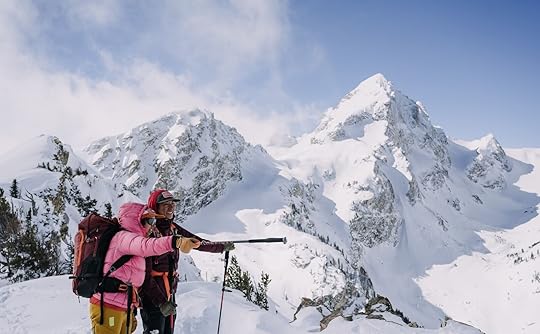
Tagged
Ski and Snow
OUTLIER: COMMON: A Powerful Story of Friendship, Adventure, and Resilience
Dani Reyes-Acosta spent much of 2020 isolated from the community of mountain athletes she’d developed over years of van-trotting the American west with a splitboard in tow. During this time she’d frequently venture to the peaks of the La Sals, close to her adopted home near the Colorado-Utah border, and as a global pandemic ravaged the world around her these peaks became a lifeline to the adventurous lifestyle, and far-flung community, she loved. This isolation, combined with a lifelong feeling of “otherness” in the outdoors, sparked in Reyes-Acosta — a filmmaker by trade — the idea for OUTLIER, a collection of short films breaking with the traditional narrative of snowsports media and bridging a gap toward a more diverse and inclusive backcountry community.
The first film in the series, TRUST, was released in 2023. The second installment in the OUTLIER series, COMMON, debuts at the No Man’s Land Film Festival in Denver on March 7 and 8. Following its release, the film will be available to view on Vimeo and at upcoming film festivals, with screening details available via the film’s website. Also featuring Vanessa Chavarriaga and Christina “Nina” Aragon, OUTLIER: COMMON is a testament to the power of community-building in breaking down barriers that have historically kept many people out of the backcountry — and the most emotionally uplifting 27 minutes of film in the outdoor space, to date.
Visit
Vanessa Chavarriaga Posada and Dani Reyes-Acosta scout a line.
Visit
Dani Reyes-Acosta cashes in on her hard work.
Visit
To go down, one must first go up. Nina Aragon, Dani Reyes-Acosta, and Vanessa Chavarriaga Posada make their way up the skin track.
The OUTLIER film series highlights under-represented voices in the outdoors
Fresh narratives in snowsports don’t come along often. Since Warren Miller’s “Deep and Light” debuted in 1950, ski films have largely followed the pursuits of white dudes attempting to out-bro one another by dropping bigger cliffs and sliding longer handrails. Female athletes, particularly women of color, have made appearances, but rarely as a lead and even less frequently as the main storyline. Historically, even snowboard films chronicling the sport’s rebel roots and open-sourced, party-hardy mantra largely failed to capture the need for a more diverse community. The “Totally Board” series peaked 25 years ago but not much has changed – most films still fail to get deeper than ski porn, park booters, and handrails, even those that chronicle the backcountry’s best jump-turning down Alaskan spines.
Reyes-Acosta is the new generation of snowsports storytelling. The Colorado-based, Los-Angeles-born athlete and filmmaker is Mexican, Filipina, and Mestiza, a diverse palette from which to paint a unique story. In the American mountain sports community, she’s an outsider in the truest sense – a sponsored athlete, a planter of trees, a farmer, yet someone who despite this profound connection to the land and mountains had always felt “othered” while in them. Her story was featured in the Livsn Productions short Well Worn Life which highlighted Reyes-Acosta’s self-reliant worldview and progress as an athlete moving through a world where she was always that “other.”
“How do we understand our identity – our definition of community, our definition of identity, and what does that all mean in the framework of belonging in this space,” Reyes-Acosta told Matador.
The OUTLIER series began production in 2021 as Reyes-Acosta’s firm statement of arrival. The series is about community. Particularly, a community for women of color in the backcountry – to let others know they aren’t alone, and that there indeed are people to look up to and reach out to in the space. She entered the Covid-19 pandemic recovering from a broken back in a remote community of western Colorado. The first film in the series, TRUST, focuses on two primary themes: her and costar Lani Bruntz feelings of connection to the mountains despite not looking like most of the people they met in them, and how that connection has shaped their worldview.
An underlying theme in the OUTLIER series is that for many people of color, particularly women, getting into the backcountry isn’t as easy as it is for others. Role models aren’t as readily available, and in many cases, even getting to the mountains wasn’t – isn’t – always easy for economic, societal, or family reasons. When speaking with the three athletes for this story, I asked each what that felt like in contrast to my own experience of looking up to Jeremy Jones and how easy it was for a guy from suburban Denver to find inspiration in someone who looked, talked, and sounded like him.
“I felt hung out to dry,” Reyes-Acosta says. “It took me moving (to the middle of nowhere) to have that mirror held up and realize, ‘Oh, it’s not just me. Over the years as a woman splitboarder, there’s always been this tension in the space. The gear was weird, there’s always been this blatant ‘othering’ that’s happened. In 2020, many factors combined to make me realize that I needed to grab the mic and say something. I wanted to translate my pain and frustration into something useful, and hopefully motivational and constructive.”
OUTLIER: COMMON furthers the narrative for diversity in the backcountryReyes-Acosta always intended for OUTLIER to be a multi-part story. The second installment brings Vanessa Chavarriaga, a Colombia-born athlete, community builder, and advocate with “Dreamer” status in the US, and Nina Aragon, a climate scientist and athlete, into the mix. What they collectively created is less of a ski film than it is a life lesson in what happens people show up for each other, no matter what. Through the ladies’ united pact, the viewer is taken on a wild, story-laden ride that ultimately holds the key to breaking down colonial barriers in the outdoors. The film touches on personal struggles each faced during its filming, including Reyes-Acosta taking care of her ailing mother and her partner as he recovered from a major surgery. The trio speak Spanish among themselves at times, and the soundtrack trades speed metal for Tropicália.
Between the film’s spoken lines is a drive for community impact. Reyes-Acosta’s production company, Afuera Productions, partners with organizations including Vamonos Outside, SOS Outreach, and Mountain Dreamers. Each film highlights the science behind a different element of climate change. In TRUST, fire and its impact on mountain ecosystems plays a central role. In COMMON, water is the star, led by Aragon’s professional background as a climate scientist.
Dani Reyes-Acosta
Visit
Dani Reyes-Acosta
Dani Reyes-Acosta
Nina Aragon
Visit
Nina Aragon
Nina Aragon
Vanessa Chavarriaga Posada
Visit
Vanessa Chavarriaga Posada
Vanessa Chavarriaga Posada
Reyes-Acosta grew up surfing in her hometown of Los Angeles, and even then felt isolated as a woman in a male-dominated space. Snowsports, notoriously populated by affluent, largely white, and mostly male figureheads, is the worst offender in this sense – especially given that to optimize your life around a sport like splitboarding means living in a small town.
The name “Outlier” comes from the scientific term for a younger rock formation surrounded by older, more consistently fluent rock formations. In the La Sal Mountains of eastern Utah, where Reyes-Acosta decided to make these films, the mountains themselves are outliers to the high desert landscape that surrounds them – much as she, as a woman of color, is an outlier in the splitboarding community.
“I looked down at the rock and thought, ‘I am this mountain,’” Reyes-Acosta says.
The film series is funded in part through a grant from the National Association of Latino Arts and Culture, along with private sponsorships and a crowdfunding campaign.
“I’ve come to accept that the chaos of life is what it is,” Reyes-Acosta says. “It felt like for so many years that the world was just punching me. Because of the chaos of life, because of my mom’s cancer, because of Nina’s complications with her pregnancy, all these things through the film for a loop. But I realized this is another ‘evolving my mindset’ moment. I spoke with our funders and was like, ‘Hey, life is happening.’ They were gracious and supported us.”
Finding partners, and identity, in the mountains“This is a universal story of realizing that we’re all outliers in some way,” Reyes-Acosta says. “We’re all a little bit weird. We’ve been trying so hard to force ourselves into this idea of what it means to be in the mountain community and to go tour.”
At the films’ heart is a chance for Reyes-Acosta and her costars to pivot their perception of self and of belonging in the high country. The simple act of ski-touring with two other women of color, and having the difficult and vulnerable conversations necessary to ensure each other’s vitality in the group, helped each of the three women in “Outlier: Common” find that sense of community – and at a grander scale, they’re decolonizing outdoor sports.
Chavarriaga, a professional athlete and environmental sociologist, uses her platform and skillsets to focus on the intersection of people and nature, through the lens of racial identity and immigrant identities. “I try to bring in conversations and education about who has access to nature, and why that is, and then how we can fix this and why we should,” she says.
The two met on Instagram during the Covid-19 pandemic. Chavarriaga was living in rural Montana. Reyes-Acosta in rural Colorado. Chavarriaga’s first time skiing was with Reyes-Acosta.
“I went to visit her and was like, ‘Are you gonna invite me to be in the second episode or what?’” Chavarriaga says.
Little did she know, the invitation was already in action – Reyes-Acosta had been planning a surprise invitation to bring her into the fold.
“I’m a pretty new skier – going into my fifth season this year, and I got into skiing in such a public way,” Chavarriaga says. “I did that on purpose, because I wanted to share that vulnerability, and show people that you don’t have to be the best to belong.”
This process, of course, involved a good amount of trial and error.
‘I fall a lot in front of the camera,” Chavarriaga laughs. “Dani has provided such a beautiful role of friendship and mentorship.”
To her, the connection between outdoorspeople’s love of movement and the issues facing immigrant rights in the United States go hand in hand. Her place in this film expresses that and attempts to connect that freedom to freedom of migration. “Certain people can exercise this movement and others can’t, and really, there is no freedom until everyone is free,” she says. ‘Collective liberation’ is the goal – and to reach it, people of all stripes must be welcoming and inviting in the outdoors.
Her father was deported. Chavarriaga herself can’t seem to pass through customs at a US airport without being detained and questioned, despite the fact that she has DREAMER status and proper documentation.
“I’ve found so much healing being able to take up space outdoors,” she says. She tries to bring that healing to others, introducing them to skiing, providing gear and knowledge, and generally promoting the inalienable truth that we all belong outdoors. “The land always welcomes all of us, and it’s an important player in the entire conversation of belonging outdoors.”
OUTLIER: COMMON highlights the importance of community, science, and advocacy in the outdoorsThe film took nearly two years to make because each of the three women were dealing with the vice of life that happens beyond skiing and snowboarding. Reyes-Acosta’s mother was clinging to life in the hospital. Aragon had recently become a mother. Chavarriaga is an immigrant with DREAMER status who can’t seem to fly through customs without being detained and interrogated. The challenges, combined with multiple filming locations — the crew shot in the Coast Mountains of British Columbia, the Tetons, the La Sals, the San Juans, and in Bend, Oregon — combined to create multiple fluctuations in the schedule.
“I called Dani and said, ‘I’m pregnant!’ and she was like, ‘Let’s bring it into the film,’” Aragon says.
Her pregnancy was deemed high risk, and her doctor insisted that she remain within an hour of a NICU. After giving birth, further care was required for her son and her husband suffered severe injuries. “It was a wild piece of life and (Dani) embraced it and was supportive,” Aragon says. “Dani decided that we were going to create a culture of caring for each other, and of showing up for each other, and it was really great.”
Aragon grew up in Denver in a large Latino family with a huge emphasis on family structure and culture. Getting into the outdoors, where the focus lies more heavily on individuality and self-motivation, did not come naturally to her. Outside of filming and family life, she is working on a PhD in water resources engineering through Oregon State University, focused on the intersection of water and climate, and how that relates to water resources. In particular, Aragon studies how snowpack impacts both where it falls as well as down-stream water resources. Climate model analysis is a big part of her work, and her knowledge plays out extensively throughout the film.
The trio ended up doing some late-season filming to get the shots required for the film. The entire process helped them develop an unwavering trust in each other – and in their ability to do this project, as life allowed them to do it, without compromising other aspects of their lives.

A poem written by Nina Aragon during the filming of OUTLIER: COMMON
“I came into this project having things I wanted to talk about and wanted to highlight, but then having a kid was so life-altering that I was actively processing what was going on as it happened,” Aragon says. “I think it’s hard to have perspective and opinions on things as its happening, and what ended up being put in the film was completely different than what was planned.”
“My family did not snowboard or ski, that’s just not something we did,” Aragon says. “Basically, the sacrifices of my parents and my ancestors afforded me time. I get a choice of what I do with that time, and there’s this idea that we’re trying to create something better for our children than we had in our lives, and our generation had this recognition that healing and overcoming generational trauma is necessary to get our kids to that next level of success, like they’re integrated and part of society.”
“The place where I did the most healing was in the backcountry,” Aragon says. This is where she came to understand the cultural differences between her family structure and that of many of her peers. She felt fortunate to have the time to go to the mountains – something that wasn’t a “thing” for her parents or grandparents.
The grander takeaway, no matter a person’s background, is to be “radically inclusive” of where everyone in your party is in their journey. Any backcountry skiers or snowboarders who’ve taken an AIARE Level 1 course have heard the mantra, “The group’s as good as the least-experienced person.” Rather than a snow-covered trope on the “weakest link” insult, this guideline is more of an ego check for experienced backcountry users to remember where they came from and the people who helped them get to where they are.
“Where am I for the day, what can I do to prepare myself fully, and if something’s going on, communicate it,” Reyes-Acosta says. “Anything that you’re trying that’s new is going to be difficult. It’s going to be painful. It might be terrifying. All of these things just require practice. People aren’t bad at things, but if we don’t have the conversations, we’ll never know how good we can be.”
Chavarriaga is routinely asked in the outdoors if she knows what she’s doing or if she needs help, simply because she doesn’t look like what the typical “outdoorsperson” expects.
“In the film we talk about finding common ground and how important that is, because if we can’t we’ll never get past these issues,” she says. “We’re trying to make a film about a marginalized community, while being that marginalized community.”
The hope of Reyes-Acosta and her costars and colleagues in the OUTLIER series is to further the conversation and spark progress.
“What I try to get folks to do always is just start with what you know, where you are, and the people you have,” Chavarriaga says. “Even looking at your neighborhood differently – noticing who makes your food or who works in the bars, noticing your neighbors. What’s cool about collective liberation is that each one of us has so many gifts to share. Start with an invitation – invite your neighbor outside for the first time. Share what you know, and if everybody did that, the world would be a better place.”
Films like OUTLIER: COMMON are a step toward that storytelling-driven solution. Film screenings focus on women’s events, BIPOC and Latino leaders events, in addition to standard screenings in mountain towns and film festivals. Regardless of where the film is viewed, one would be heartless to watch these three skiers and activists go about this journey without feeling empathy and, ultimately, pride in what they’re doing. This pride and empathy is the key to unlocking broad systemic change – in how society addresses massively complicated issues, in how humans interact with each other, and yes, even in whom we’re sharing the slopes with on a powder day. 
The World Is Waiting: Travel Host Darley Newman On Season 12 of ‘Travels With Darley’

Creating and hosting a long-running travel show is no easy feat. Just ask Darley Newman, host of “Travels With Darley,” which debuts its 12th season on PBS beginning this month. Newman, who founded the show and at various points has published episodes across platforms including YouTube, Amazon Prime, and Ovation TV, in addition to PBS, shares insights into the latest season of her acclaimed series, “Travels With Darley.” Newman discusses the unique destinations explored in Season 12 and delves into the show’s focus on sustainable travel and community engagement. She also reveals behind-the-scenes anecdotes and shares her hopes for inspiring viewers to explore their own corners of the world.
Where to watch Season 12 of ‘Travels With Darley’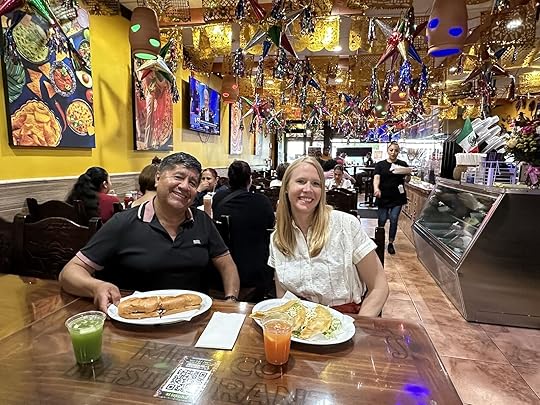
Exploring the cuisine of New Jersey. Photo: Darley Newman
As has been the trend with the past 11 seasons, Season 12 of Travels with Darley takes viewers on journeys around the US and into Canada, exploring diverse cultures, history, and landscapes. Newman immerses herself in local experiences, interacting with people beyond destination representatives, trying local cuisine, and participating in unique activities. The defining feature of the show is Newman’s ability to blend cultural history with actionable things that people can do beyond simply staring at a museum plaque. The show has garnered critical acclaim and has been nominated for several Daytime Emmy Awards.
Season 12 of “Travels with Darley” takes viewers to a diverse range of destinations across the USA and Canada. The season kicks off exploring the rhythms, tastes, and trails of Detroit, Michigan, before heading to the Southwest to immerse viewers in the Santa Fe Indian Market in New Mexico. Then it is off to Fargo, North Dakota, and beyond, followed by a multi-state “Revolutionary Road Trip” – a staple of Travels With Darley throughout the show’s history – through Delaware, North Carolina, and New Jersey. The season also includes a stop in Ellijay, Georgia, a road trip from Albuquerque to Ruidoso, New Mexico, and a scenic drive along the Illinois Great River Road. Back in the Midwest, viewers can explore the architecture and the Magnificent Mile in Chicago, Illinois, before the season concludes with eco-adventures in Quebec, Canada.
The series highlights lesser-known aspects of many popular tourist spots, as well as places travelers may never think to visit in the first place (North Dakota being a prime example in Season 12). It aims to inspire viewers to explore the world, embrace new cultures, and discover the beauty and wonder that exists beyond typical travel itineraries.
“I’m excited to share those places that again fly under the radar, but that are doing really good work and you would never hear about exactly what they’re doing,” Newman told Matador.
A deeper focus for the new season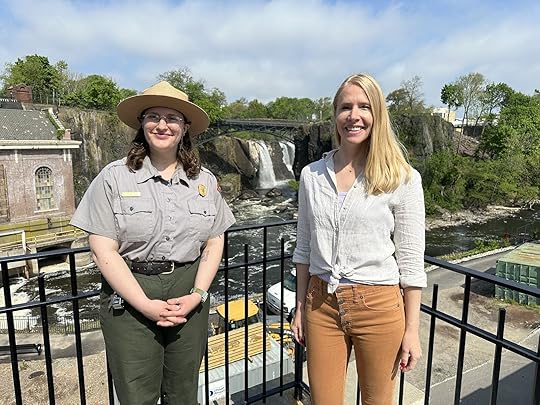
Photo courtesy Darley Newman
Each season of “Travels With Darley” has an underlying theme that becomes apparent to the viewer as they move through the episodes. Season 12 focuses on the broad scope of sustainability.
“Not just environmental sustainability,” she says. “It’s also preserving architecture, which I love to cover, and preserving culture and history and passing down traditions. That’s all a part of true sustainability and that’s what this season is all about.”
Another constant in the new season is its focus on inclusivity and accessibility. Many of the destinations featured, including Alabama, North Dakota, and New Orleans, each of which has taken strides to make top sites easier to reach or more tolerable for travelers with disabilities such as autism.
“It’s a big topic because (accessibility) is another growing trend it’s something that destinations are really looking at right now,” Newman notes. “There are so many different challenges that we all face.”
Autism, in particular, is a notable issue that prevents millions of people from enjoying travel to its fullest, or even leaving home in the first place. Surfside, South Carolina, became the first city in the U.S. to be sanctioned as autism-friendly, and Newman was recently in Myrtle Beach, where she is from, for the holidays and learned about Surfside’s work in this area, which includes erecting playgrounds that are sensitive to overstimulation, and museums and restaurants that are the same. For season 12, she took inspiration from other places that were making similar efforts.
“I think it’ll be a season that has a lot of surprises for people and there’s some heartfelt stories mixed with things that just aren’t what we see or hear about every day, which I love,” Newman says.
How Darley Newman stays motivated, 12 seasons in
Photo courtesy Darley Newman
Even as a veteran, Newman’s excitement for conveying the stories of the people and places she visits remains visible throughout Season 12.
“I always like to understand people’s motivations when we’re doing the show,” she says. “Why people are inspired to do what they do, because there are things you have to do in life but then there are things that compel you to do something more. And I think those are often the things that are the most interesting to be able to uncover. It’s the passion that people have for something.”
It’s finding that passion and a unique angle that Newman says keeps her engaged, and that she offers as her biggest piece of advice for travel content creators.
“I think if you have a passion for something that you really care about or you think you’re really good at, then that should be part of your focus,” Newman says. “Because you have to spend a lot of time doing this, and creating a channel, and all that kind of stuff. So, it should be something you really care about and that you’re passionate about and maybe is unique to you as well.” 
Check out season 12 of “Travels With Darley” on your local PBS station and for free online via Tubi.
More like thisTravelThis YouTuber Became the First Person to Drive Around the World in an EVThis Tropical Island Has Some of the Most Unique Food in Africa

Most travelers landing in Zanzibar grab their bags and head straight for the white sand beaches and warm waters of Paje, Jambiani, or Nungwi. It makes sense — the tropical island in East Africa, located just off the coast of mainland Tanzania, is best known for its miles and miles of gorgeous coastline.
Resorts and hotels line those beaches with sunset views, infinity pools, and stylish restaurants every few steps. It’s easy to spend a week there without leaving the shoreline (or even your lounge chair).
But skipping Zanzibar’s cultural capital, Stone Town, means missing out on something special. As a UNESCO World Heritage site, Stone Town is a living museum of Swahili culture with Arab, Indian, and European influences reflected in its winding alleyways, vibrant markets, and historic architecture.
And as with most destinations, its historical influences have shaped its food. From fragrant spices to fresh seafood and fruits plucked straight from trees, the island’s dishes tell the story of its history. And in the last few years, a handful of culinary tours, cooking classes, and farm-to-table experiences have made it easier than ever to gain a deep understanding of Zanzibar’s food culture.

Fresh seafood is a staple of Zanzibari cuisine. Photo: Denys R/Shutterstock
Zanzibar’s food culture is a reflection of its history as a key trading hub in the Indian Ocean.
For centuries, the island’s strategic location attracted merchants, settlers, and travelers from Africa, the Middle East, India, and Europe. Each left their culinary mark.
“We have all these different cultures that have influenced us. Our history is so rich. This is what makes Zanzibari cuisine different from the rest of Swahili cuisine,” says Maskat Shineni, founder of Mamas of Zanzibar, a Swahili cooking class that teaches visitors how to prepare traditional Zanzibari dishes. Swahili cuisine spans East Africa’s coastal regions, including Kenya, Mozambique, and Tanzania, and is known for its slow-cooked coastal dishes with bright flavors and fragrant spices.
At its core, Zanzibari food is defined by what the island provides. Fresh seafood, tropical fruits, and staples like cassava, plantains, and sweet potatoes form the foundation of many of its dishes. Coconut is a key ingredient thanks to the island’s plentiful palm trees, and is used in cooking far more often than in Tanzania’s mainland cities, such as Dar Es Salaam.

Urojo is a popular dish in Zanzibari cuisine. Photo: CapturedNouns/Shutterstock
Spices are another hallmark. Originally brought by Arab traders for commerce, spices have become deeply ingrained in Zanzibari food. But what sets it apart is how these spices are layered to create bolder, more complex flavors. “Our main spice is the clove—this is the karafuu,” Shineni notes. Cloves, grown abundantly in Zanzibar, impart a sweet warmth that defines many of the island’s dishes, like pilau rice. “We also use cardamom, black pepper, turmeric, and ginger,” she adds, explaining that the way Zanzibaris blend these spices is what makes them distinct. For example, cloves are paired with coconut milk in curries to create a rich, fragrant base.
Zanzibar’s cuisine highlights its history in other ways, too. Omani traders introduced pilau spices. Indian settlers brought curries, chapati, and samosas. Portuguese traders added citrus fruits to the mix, and British colonists helped shape tea culture.
Even with these layers of influence, Zanzibari cuisine keeps its own distinctive identity. One local favorite is kisamvu — cassava leaves that are pounded with garlic, onion, chili, and salt, before being boiled and finished with coconut milk. “When you’re pounding the leaves, the smell is so delicious,” says Shineni.
Seafood stews, like samaki wa kupaka (whole fish cooked in coconut milk with turmeric), are also staples, especially in coastal and rural areas. Breakfasts are typically hearty, boiled dishes like cassava and fish soup, and for celebrations, biryani takes center stage. It’s a tradition introduced through the island’s Indian populations. “Every Friday, you’ll find biryani and pilau on the menu in most homes. The spices give it a wonderful aroma,” explains Shineni.

The night market in Stone Town is popular with both locals and tourists. Photo: damn12/Shutterstock
Zanzibar is also home to tasty street foods, like urojo, also known as Zanzibar mix. This tangy, soup-like dish is made with a turmeric-infused mango broth and is typically served with a mix of fritters, boiled potatoes, hard-boiled eggs, and spiced meat or seafood. Coconut chutney, chili, and tamarind sauce are added as toppings.
Another popular street food is Zanzibar pizza, a savory and slightly sweet flatbread dish that’s pan-fried to golden perfection and stuffed with ingredients like minced meat, vegetables, egg, and cheese. You’ll find both dishes at a handful of busy booths at the Forodhani Gardens Night Market in Stone Town.

A fresh spread during a Mamas of Zanzibar cooking class. Photo: Riley Chervinski
One of the best ways to experience Zanzibar’s traditional food culture is through a cooking class, like the ones run by Mamas of Zanzibar. Located just outside Stone Town, this half-day experience introduces you to some of the island’s time-honored dishes while connecting you to the women who keep them alive.
Founder Shineni hosts the classes in her own home, giving guests a chance to cook the way locals do, rather than being in a hotel setting or commercial kitchen.
In her classes, guests start at the local market, where they shop alongside the Mamas, helping pick fresh ingredients for their dishes. Back at the open-air kitchen, you’ll roll up your sleeves and learn to make dishes like the aforementioned kisamvu and samaki wa kupaka, or ndizi tamu (plantains in coconut milk). Students use traditional tools like the mbuzi (coconut grater) and cook over clay charcoal stoves called seredani – two everyday staples of Zanzibar food preparation.
Shineni worked in hotels on the island for more than 15 years, during which time she realized that typical tours and activities were leaving guests feeling disconnected from the local culture.
She notes that guests would come to her wanting authentic experiences, which was difficult, as “most of the activities we had were touristy, so cliche, so advertised, and not really traditional,” she says. So, she started Mamas of Zanzibar to fill that gap in the tourist market and give guests a glimpse into local life.
Visitors to Zanzibar can also learn to cook straight from the source at Msonge Organic Family Farm, about 20 minutes outside Stone Town. The farm’s cooking classes give visitors hands-on experience with traditional Swahili dishes, using fresh ingredients harvested directly from the surrounding fields. The farm also offers farm tours to learn about Zanzibar’s native and introduced crops, see (and taste) what’s in season, and see how the small farm is using modern organic farming techniques.

Lunch dishes at Msonge Farm. Photo: Riley Chervinski
In Zanzibari culture, dining is seen as a way to build community and celebrate life. Meals are traditionally shared, and sitting on the floor to eat, a common practice in Swahili households, creates an intimate atmosphere.
Even today, this communal style of dining remains especially strong in rural areas and during special occasions, where meals are served on majamvi (Swahili straw mats) and shared from large platters.
You can experience this traditional approach to dining firsthand at Msonge Organic Family Farm. Every Sunday, the farm hosts a farm-to-table lunch, where guests are seated on majamvi in lush gardens surrounded by fruit trees and vegetable fields. The buffet-style meal showcases traditional Swahili dishes made entirely from ingredients grown or raised on the farm, along with freshly pressed juices from seasonal fruits like mango and tamarind.
More information on Msonge Farm’s cooking classes and farm-to-table lunches is available on its Facebook and Instagram pages. Reservations can be made via WhatsApp (+255 778 778 760 or +255 754 536 630).

Photo: Steffen Boerner/Shutterstock
Chumbe Island Coral Park, Zanzibar’s first marine conservation area, is best known for its thriving coral reefs and dense, biodiverse forests, as well as being a critically important sanctuary for endangered sea turtles and rare coconut crabs. It’s also a great place for a delicious, eco-conscious dining experience.
Visitors can book a day trip or stay overnight at the Chumbe Island Eco-Lodge, a small, award-winning eco-resort that operates sustainably and offers immersive experiences for its guests.
Included in a day trip to the island is a Swahili-inspired lunch featuring daily catches like grilled fish in coconut curry and octopus stew. Everything on the menu is prepared with seasonal, locally sourced ingredients, and the island’s staff actively follow sustainable fishing guidelines, avoiding ecologically sensitive fish species and promoting alternatives that support their conservation efforts.
Day trips cost $110 USD per person and include boat transport to and from the island, guided activities, and snorkelling equipment. Day trips are limited to ensure minimal environmental impact and can only be booked up to four days in advance. Note that the island is closed for annual maintenance for a month, usually beginning in mid-April.
View this post on Instagram
A post shared by Emerson Zanzibar Hotels (@emersonzanzibar)
Taarab music is the signature sound of Zanzibari culture and is heard especially often during special occasions and evening gatherings on the island.
Originating in the late 19th century, Taarab became a defining musical style in Zanzibar under the patronage of Sultan Barghash bin Said. Its soulful melodies are a fusion of Swahili, Arab, and Indian sounds, performed with instruments like the oud and qanun and accompanied by poetic Swahili lyrics that tell stories of love, longing, and life on the islands.
To experience an evening of tasty Zanzibari food and taarab music, travelers should visit the Emerson on Hurumzi Rooftop Tea House. There, guests sit on colorful Persian rugs, Swahili-style, and can sample a three-course menu of seasonal ingredients sourced from local markets and nearby organic farms. The evening is set to the soulful tunes of traditional taarab music by musicians from the Dhow Countries Music Academy, the only professional music school in Zanzibar.
Zanzibar is so much more than just its beaches, and its food scene invites you to connect with its culture, history, and people. Exploring it should be on every traveler’s list. 
How the Royal Observatory Greenwich Became the Center of Time

In 2025, London’s Royal Observatory in Greenwich is celebrating 350 years of interpreting the stars and measuring time around the world.
The science of astronomy has always been an alchemy of observation, calculation, and exploration. For centuries, mariners relied on the stars, and travelers in the Islamic world used astrolabes (handheld navigation tools) to ensure they were facing eastward and the time for daily prayers. But as trading routes developed and maritime power across the world increased, there developed an urgent need for more accurate navigation methods.
The Royal Observatory Greenwich was founded in 1675 by King Charles II and played a crucial role in the development of astronomy and navigation. King Charles II appointed John Flamsteed as the first official government astronomer, known as the “Astronomer Royal,” on March 4 of that year. His instructions were simple: The role of the Astronomer Royal was to study the stars and astronomical movements to calculate longitudes, making navigation safer. Knowing your longitude (an east-west position) and latitude (a north-south position) at sea allowed sailors to know their precise locations, avoid getting blown off course by winds and currents, and map safer routes for fewer shipwrecks.x
The observatory is most famous for defining the Prime Meridian, which divides the Earth into the Eastern and Western Hemispheres, and for establishing Greenwich Mean Time (GMT). As the hub of many scientific measurements and discoveries, Greenwich is one of the finest places in the world to appreciate the history behind navigation, time, and space.

The Clipper in front of Greenwich Park. Photo: Aerial-motion/Shutterstock
The best way to get to Greenwich is via the Thames Clipper, a boat on the River Thames, where you’ll have some of the finest views of London. It’s a historic route taken by kings and queens, astronomers, and traders for centuries. (It’s also the route by which Henry VIII’s wife Anne Boleyn left Greenwich in 1536 on her way to be executed at the Tower of London.) Today, a section of this waterway and surrounding buildings are a UNESCO World Heritage Site known as Maritime Greenwich.
Maritime Greenwich has an incredible collection of historic sites, including the National Maritime Museum, the Old Royal Naval College, the Cutty Sark (a nearly 200-year old trading ship) moored in the harbor area, and the Royal Observatory. It’s centered in Greenwich Park, where a walkway winds through the trees up the hill to the Royal Observatory — and one of the finest views of downtown London in the area.
Tickets are 24 pounds ($29.50) for adults and 12 pounds ($14.75) for kids. It includes a self-guided audio tour, but extra activities (like planetarium shows) are extra. You can buy your tickets and choose your admission time in advance online.
Sites of the Royal Observatory GreenwichFlamsteed House

Guests can go inside the original Flamsteed House. Photo: Royal Museums Greenwich/National Maritime Museum, London
Entering Flamsteed House in the Royal Observatory is like stepping back in time. It’s a unique building equipped with powerful telescopes on the upper levels. It’s where Flamsteed and future successors lived with their families (and was probably the ultimate in 17th-century work-from-home setups).
The Royal Astronomers viewed the stars from the “Octagonal Room” above the living quarters, timing and charting their movements, known as transits. From here, Flamsteed also mapped a “transit quadrant,” which became known as the “Greenwich Meridian.” Eventually this became the Prime Meridian (or Zero Degrees Longitude), and is the point from which all points east and west can be measured.
Over the years, as instruments became more sophisticated, successive Astronomers Royal were able to refine the measurements even more, slightly moving the lines. Then, in 1850, a new telescope known as the Airy Transit Circle (named after the seventh Astronomer Royal, George Biddell Airy) was designed for the Royal Observatory. The following year, this became the official instrument measuring time zones around the world.
View this post on Instagram
A post shared by Royal Museums Greenwich (@royalmuseumsgreenwich)
A visit to the Royal Observatory wouldn’t be complete without a look at the stars in the adjacent Peter Harrison Planetarium. Led by expert astronomers, the shows provide excellent insights into planetary activities in one of the world’s most famous scientific centers. Multiple shows run every week on themes ranging from exploring the solar system to kids shows, Chinese Astronomy, astronomy and Islam, and special shows in foreign languages and for people with ASD and other sensitivities. Tickets are 12 pounds for adults and 6 pounds for children, or about $14 and $17, respectively.

Photo: Igor Paszkiewicz/Shutterstock
Today, visitors to the Royal Observatory Greenwich can stand on the Prime Meridian, with one foot in the East and one in the West – literally. The Prime Meridian divides the Western and Eastern hemispheres and is the epicenter of the UTC (Coordinated Universal Time) time standard. It’s the single consistent reference point used for setting every other time zone (but is not a time zone in itself) and is used by global and international industries. The aviation sector relies on it for precise flight schedules and air traffic control, finance agencies use for global timestamps, and scientists working around the world use it to ensure observations and measurements are recorded with precise accuracy.
Nearby is the first-ever clock to show the official Greenwich mean time to the public, still standing at the Shepherd Gate entrance near the Prime Meridian line. The next time you have to set your watch for traveling, remember that the origins of why that is begin right here.
The Royal Observatory itselfView this post on Instagram
A post shared by Royal Museums Greenwich (@royalmuseumsgreenwich)
There’s more to see inside the Royal Observatory in Greenwich, including the Great Equatorial Telescope. It’s the world’s eight-largest telescope, still used for astrophotography and mapping double stars (stars that are so close together, they appear to be one). Housed in an onion-domed building, it’s a highlight of any visit to the Royal Observatory. The telescope is rotational and aligned to the earth’s axis, moving parallel to the equator.
Also within the Royal Observatory are fascinating displays of astronomical and navigational interest, including early chronometers used to measure longitude at sea during the 18th century. The famous clocks enabled sailors to both calculate longitude and know the time at sea, preventing marine marine accidents and making trade and commerce safer and more robust.
But it’s not the only innovation developed by Royal Astronomers. In 1767, Astronomer Royal Nevil Maskeline developed a Nautical Almanac. Using the Nautical Almanac involved some mathematical calculations, but was generally less complex than maintaining and operating a highly precise chronometer. Each year, this book of astronomical data was updated by astronomers across the globe, all sending information to Greenwich. It became a critically important tool for navigators around the world, and without it, we may not have the cultural exchanges, knowledge, and bonds the world has today.
There are also changing exhibitions, ranging from displays on pirates and astronauts to deep space phenomenon, night sky photography, naval fashion, and more.

Photo: TheBreadLoaf/Shutterstock
The National Maritime Museum is also in Greenwich Park and has several highly professional and extremely fascinating displays relating to navigation and time. You’ll find exhibits on historical polar exploration, maritime instruments, and clever artifacts relating to astronomical photography. Displays reflect the genius and creativity of the astronomers who worked in Greenwich and across the globe to further science by observing the stars.

Photo: david muscroft/Shutterstock
The Old Royal Naval College dates from 1660 and is rich in history. It was originally planned as a palace for King Charles II, but instead became a hospital for mariners before becoming a Navy college. One of the highlights is the Painted Hall, completed in 1726 to commemorate the “Glorious Revolution:” the accession of King William III and Queen Mary in 1683. The entire ceiling celebrates Britain’s power as a maritime nation and is one of the most important pieces of art from the 18th century, occasionally referred to as “Britain’s Sistine Chapel.”
If you visit, note one corner of the ceiling on which artist James Thornhill painted his friend John Flamsteed predicting a total solar eclipse that fell on April 22, 1715. In his lifetime, Flamsteed correctly mapped more than 3,000 stars, and an atlas he wrote was published posthumously by Thornhill. Also in the painting are references to Nicholas Copernicus and his contribution to science and astronomy.

View of the Royal Observatory Greenwich, after 1774, by John Charnoch. Photo: Royal Museums Greenwich/National Maritime Museum, London
The Royal Observatory will celebrate 350 years in 2025 and is holding several special events, including specialist talks and exhibitions. Organizers are planning special shows throughout the year depicting what the night sky looked like in 1675, as well as presentations on the history and founding of London’s only observatory.
Though the anniversary will be celebrated all year, there are three specific dates that are especially important: March 4, when Flamsteed became the first Astronomer Royal; June 22, when the observatory was formally created; and August 10, when the first stone of the observatory was put in place.
More details are available here and will be added throughout the year. 
This Cozy Winter Escape Is a Train Ride Away From NYC

It’s cold outside, it gets dark too quickly, and with every drop in temperature and daylight, I became further convinced that winter is the worst time of year. But just as I started to bemoan the loss of those warm summer days, I found myself hopping a train to the Adirondacks and getting cozy at The Lodge at Schroon Lake, where my perspective began to shift.
Schroon Lake is a hamlet in New York’s Adirondack Park that’s less name-recognizable than neighbors like Lake Placid and Lake George but has nonetheless garnered a reputation for all-season recreation and all-around pleasantness. It’s long been a popular summer destination for New York City residents (and some East Coast Canadians) who head north (or south) to lounge lakeside, hike the nearby trails, and generally enjoy the warm weather.
I visited Schroon Lake just ahead of the winter holidays. Turns out, the popular summer resort has just as many opportunities for cold-weather recreation, and The Lodge at Schroon Lake makes for the perfect base camp during the frosty season.
A lakeside lodge that’s magical in the winter
Photo: Angelique Herring
The stumps of the snow-capped mountains surrounding Schroon Lake were dotted with the warm yellow glow of homes and cabins when I got to The Lodge at Schroon Lake. It was growing darker by the minute as dusk turned to night, but the lights from Christmas decorations lit my path as I slowed down to enjoy a snowy walk over to the lodge’s tavern, The Brown Swan, for a welcome meal. In an instant, Schroon Lake made me fall in love with winter.
The property’s two-bedroom chalets have some of the best views of the lodge’s namesake lake. From the first of two balconies in my spacious cabin-style lodging, I peered beyond the Christmas tree on my porch at the water body below. Adventure-themed accents, like a map of the Adirondacks with miniature metal mountaineers climbing the face of the mountains, helped to set the outdoorsy scene in my room. But the chalets are also outfitted with all of the amenities you need to enjoy a restful stay, including a kitchenette (with a Keurig machine).

Photo: Angelique Herring
Other accommodation options at the Lodge at Schroon Lake include the two-bedroom Owl’s Nest House, rooms and suites in the main lodge, and suites in the separate Longhouse. In the summer, the property also has glamping tents.
Amenities outside of the rooms are largely centered on recreation. There’s a marina that’s open seasonally with kayaks, paddleboards, and pontoon boats for rentals or tours. But even if you’re visiting in winter when the marina is closed, you’ll want to know where it is as a reference point for strolls to the lake. From the top of the marina, just downhill from the lodge, you’ll find one of the best spots on the property to take in a quiet sunrise over the lake. From there, it’s a short walk to the town dock, and you can walk along the ice taking in the scenery.

Photo: Angelique Herring
For a year-round water activity, head to the lodge’s pool. Swimming through warm water in the dead of winter has an irresistible luxury to it. Looking out onto pines and chalets framed by icicles and snow, I floated around the heated pool before hopping into the hot tub for good measure. For an extra dose of grandeur, I took a few minutes to sit in the sauna. There, in a little wood-paneled room with the heat set to 200ºF, I felt every possible worry steam away.
Beforehand, I stopped by the game room next door and was soon greeted by a friendly pair of brothers looking to play a game of billiards. We had our pick of foosball, air hockey, and tick tac toe for round two, but I wasn’t looking for a rematch — after all, the pool was calling.
A slew of holiday-themed activities
Photo: Angelique Herring
At The Lodge at Schroon Lake, chilly winter nights are an invitation to step outside and immerse yourself in a snowy wonderland with the Sugar Plum Express Wagon. When I visited, the big red Christmas-light-adorned wagon picked me and some others up outside of The Brown Swan and whisked us away on a short ride through the lodge’s holiday light display. But that’s just the beginning of the winter offerings.
Winter Friday nights see the lodge’s ballroom transformed into a theater where guests can watch holiday classics on the big screen. I stopped in for a few minutes of Will Ferrell’s familiar antics in Elf, appreciating both the warm laughter that filled the room and the beautiful white lights that were wrapped around the wooden banister.

Photo: Angelique Herring
At The Bevy, the outdoors-themed lounge in the main lobby, there are themed social events. When I was there, the space was transformed into a flannel-lined dance floor during an ugly sweater party. Both guests and locals made merry as bejeweled cowboys and bartenders dressed as elves grooved to covers of Americana classics while sipping on sugar-cookie cocktails and voting on the ugliest sweater of them all.
The Bevy was also where I got to update my wish list over pancakes and parfait with Santa Claus and Mrs. Claus. Jolly as ever, the pair posed for photos with lodge visitors as they stopped in for the buffet breakfast and pancake station.
A final activity that added a pleasant, holiday-themed flair to my stay was a crafting exercise. Before checking out, I sat down to make a Christmas ornament at the arts and crafts table in The Bevy — 20 minutes later, I walked out with a handsome pair of wooden art pieces to remember my trip by and adorn next year’s Christmas tree.
Where to eat and drink in Schroon LakeThe Brown Swan and The Tavern
Photo: Angelique Herring
Open to both guests and the public, The Brown Swan is the go-to lunch and dinner restaurant at The Lodge at Schroon Lake. The menu features a wide variety classic orders (think filet mignon, French onion soup, fish and chips, and wedge salad) alongside some more creative plates like the “fuhgeddaboudit” flat bread with Italian sausage, peppers, onions, mozzarella, and red sauce. The extensive cocktail menu meant there was always a drink to pair with my meal, too.
Just on the other side of The Brown Swan there’s another drinking and snacking spot called The Tavern. It serves bar-style eats like mozzarella sticks and Bavarian pretzels in an old-fashioned wooden tavern that was tastefully lined with tinsel during holiday season. I had the short rib poutine and would recommend the traditional Canadian dish to anyone looking for comfort food.
The Brown Swan and The Tavern: 210 Registration Way, Schroon Lake, NY 12870
The BevyWinter breakfasts at The Bevy, which are included with your stay at The Lodge at Schroon Lake, include made-to-order pancakes and a traditional buffet with all of the usual American fixing. Breakfast is served from 7 AM to 10:00 AM and is the perfect start to a day exploring Schroon Lake.
The Bevy: 210 Registration Way, Schroon Lake, NY 12870
9 Mile Coffee
Photo: Angelique Herring
Every town has its go-to coffee spot. For Schroon Lake, that spot is 9 Mile Coffee. Just a short walk from the lodge, 9 Mile Coffee serves quick eats like bacon, egg, and cheese croissant sandwiches along with hot coffees and chai. Make sure to grab a cozy cup of joe at 9 Mile Coffee to warm you up after your morning walk around the lake from the lodge.
9 Mile Coffee: 1077 US-9, Schroon Lake, NY 12870
Paradox Brewery
Photo: Angelique Herring
Paradox Brewery in North Hudson (about 15 minutes from the lodge by car) has all manner of local beer and classic pub grub. Pizza is a popular order there, but it was the stromboli that came highly recommended by a local seated at the table behind me — generously stuffed with meat, cheese, and veggies, it paired perfect with the Paradox German Helles ale I ordered.
In winter, Paradox Brewery also hosts a holiday market. When I visited, I wandered around and perused jewerly made from local Adirondacks rocks and stones while passionate artisans shared their longstanding family connections to the region. After souvenir shopping, take your treasures next door to the main brewery for live music and a bite to eat. On the way over, stop to take in the view of the nearby mountains — a perfect backdrop to this Hudson Valley staple.
Paradox Brewery: 2781 US-9, North Hudson, NY 12855
How to get to and around Schroon Lake
Photo: Angelique Herring
There are many ways to get to Schroon Lake. One of the most scenic options is to go by train. The nearest train station is 45 minutes from the lodge at Fort Ticonderoga. From New York City, the ride is just under six hours along the Hudson River, and you can arrange for the lodge to pick you up in a shuttle at the train station.
Once at the lodge, on-property activities are all a walk away. Downtown Schroon Lake is easy to access from the lodge (just a 10-minute walk from the lobby) and explore on foot, as well. Schroon Lake is also within driving distance of skiing and snowboarding areas like White Face and Gore Mountain. Since rideshares are a rare find in this part of the Hudson Valley, I’d recommend checking with the lodge about its shuttle service if you’re interested in those drives. 
Matador Network's Blog
- Matador Network's profile
- 6 followers



